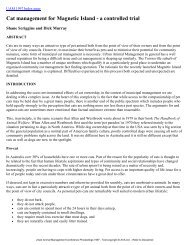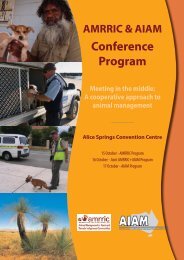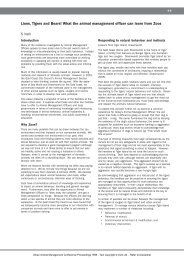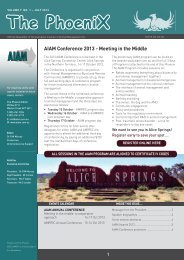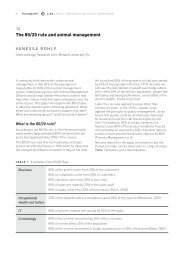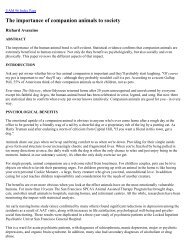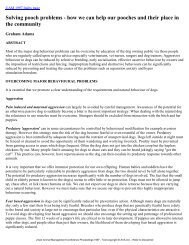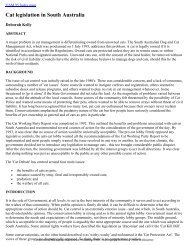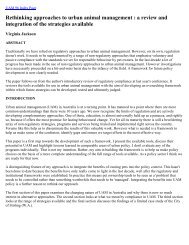Proceedings OF ThE - Australian Institute of Animal Management Inc
Proceedings OF ThE - Australian Institute of Animal Management Inc
Proceedings OF ThE - Australian Institute of Animal Management Inc
You also want an ePaper? Increase the reach of your titles
YUMPU automatically turns print PDFs into web optimized ePapers that Google loves.
12 <strong>Proceedings</strong> 2012<br />
AIAM Annual Conference on <strong>Animal</strong> <strong>Management</strong><br />
Process dissection<br />
The above discussion is essentially about the “why”<br />
<strong>of</strong> <strong>Animal</strong> <strong>Management</strong> and the clarity we now have,<br />
after twenty consecutive annual conferences, in<br />
this respect has been beneficial. In more recent<br />
times, the <strong>Institute</strong> has sought to also gain a better<br />
understanding <strong>of</strong> the “how” <strong>of</strong> <strong>Animal</strong> <strong>Management</strong>.<br />
To achieve this, an effort has been made to “unpack”<br />
<strong>Animal</strong> <strong>Management</strong> into its operational components<br />
or functions – as they relate to Local Government<br />
processes. The following “unpack” involves a breakdown<br />
into five key <strong>Animal</strong> <strong>Management</strong> service functions 15 .<br />
1. Governance process – Policy, Audit, Risk,<br />
Reporting, Legislation, Advocacy<br />
2. Planning process – Strategic, Operational,<br />
Reporting, Advocacy<br />
3. Service delivery process – Information,<br />
Advice, Education, Compliance/Enforcement,<br />
Partnerships/Relationships/Collaboration,<br />
Consultation, Advocacy<br />
4. <strong>Management</strong> efficiency process – Vertical/<br />
Horizontal integration, Informed decisions,<br />
Recruitment, Training, Mentoring, Continuing<br />
Education, Information Repository/Library,<br />
Advocacy<br />
5. Quality control process – Service Level<br />
Agreements, Community/Councillors/Staff,<br />
Reporting/Benchmarking, Surveys, Audits,<br />
Review, Reinvent<br />
Because <strong>Animal</strong> <strong>Management</strong> has historically<br />
tended to be a service “tacked on” to some other<br />
departmental entity in Councils, it is possible that<br />
clear functional dissections specifically for <strong>Animal</strong><br />
<strong>Management</strong> may not in some cases have been<br />
carried out. “Unpacking” this and complex, important<br />
and <strong>of</strong>ten demanding service is a part <strong>of</strong> seeing how<br />
it all should come together in a framework that can<br />
be best understood.<br />
Achievements<br />
It is probably true to say that working out the “why<br />
and how” <strong>of</strong> <strong>Animal</strong> <strong>Management</strong> has taken all <strong>of</strong> the<br />
past twenty years <strong>of</strong> doing annual national <strong>Animal</strong><br />
<strong>Management</strong> conferences to achieve. As a result <strong>of</strong><br />
this, however, the <strong>Institute</strong> can now say with confidence<br />
that it knows what <strong>Animal</strong> <strong>Management</strong> really is.<br />
And there is now an equally clear appreciation <strong>of</strong><br />
both how it should be done and what most needs to<br />
be done now. This is a fair achievement in itself and<br />
though it might seem (over 20 years past) to be pretty<br />
slow going, perhaps not so.<br />
The following anecdote about Yosemite National Park<br />
from Tim Adams 16 is instructive in the context <strong>of</strong> this<br />
business <strong>of</strong> having to work it out as we went along.<br />
“Sometimes it takes a while to develop a new idea<br />
to its completion. I was struck by this notion on a<br />
visit to Yosemite National Park in the Sierra Nevada<br />
mountain range in California: a park ranger told us the<br />
story <strong>of</strong> how even after the area became protected by<br />
law, pioneers and decision makers still hadn’t finally<br />
resolved what it meant to be a National Park.<br />
[The following is lifted from Wikipedia, and agrees with<br />
the story as told by the park ranger] – “Concerned by<br />
the effects <strong>of</strong> commercial interests, prominent citizens<br />
including Galen Clark and Senator John Conness<br />
advocated for protection <strong>of</strong> the area. A park bill was<br />
prepared with the assistance <strong>of</strong> the General Land Office<br />
in the Interior Department. The bill passed both houses<br />
<strong>of</strong> the 38th United States Congress, and was signed by<br />
President Abraham Lincoln on June 30, 1864, creating<br />
the Yosemite Grant. This is the first instance <strong>of</strong> park<br />
land being set aside specifically for preservation and<br />
public use by action <strong>of</strong> the U.S. federal government, and<br />
set a precedent for the 1872 creation <strong>of</strong> Yellowstone as<br />
the first national park.” (emphasis is mine)<br />
One <strong>of</strong> the most interesting parts <strong>of</strong> the ongoing story <strong>of</strong><br />
National Parks in the USA – and Yosemite in particular –<br />
is that it seemed to take many decades before the Park<br />
was defined in a way we would now regard as a modern<br />
National Park. For example – in the late 19th century,<br />
the area suffered from overgrazing by sheep, and was<br />
home to an encampment by the US Army. In the early<br />
20th Century a dam was built within the boundaries<br />
<strong>of</strong> the National Park to supply water and power to<br />
residents in neighbouring counties and San Francisco.<br />
The park was even subject to a bid for the Winter<br />
Olympics in 1932.<br />
These days, preservation <strong>of</strong> the natural environment<br />
within the park is the priority. Car use within the<br />
Yosemite Valley is strongly restricted, with electric<br />
shuttle buses running instead. Feeding animals is<br />
banned, and the penalties for doing so are steep. Visitor<br />
numbers are managed closely, and the rangers conduct<br />
daily free tours on various topics relating to the natural<br />
environment.<br />
Yosemite National Park was a whole new idea in the<br />
beginning. It has taken about 100 years for YNP<br />
custodians to work out how this land should be<br />
managed in a way we might identify today as a modern<br />
National Park. In other words, it seemed to take a<br />
century for this National Park to figure out exactly what<br />
it meant to be a National Park. 17 ”<br />
15 Pers comm. Shane Scriggins NCCC, April 2012.<br />
16 Pers Comm Tim Adams, PIAS. April 2012.<br />
17 Pers Comm Tim Adams, April 2012



